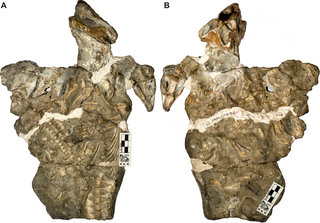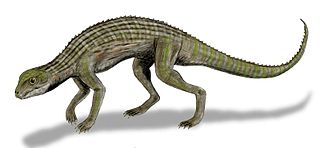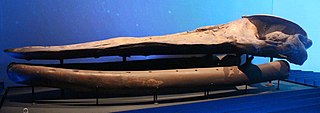
Galesaurus is an extinct genus of carnivorous cynodont therapsid that lived between the Induan and the Olenekian stages of the Early Triassic in what is now South Africa. It was incorrectly classified as a dinosaur by Sir Richard Owen in 1859.

Psephoderma is a genus of placodonts very similar to the related genera Placochelys and Cyamodus. Psephoderma had a flattened skull and a narrow, straight rostrum, much narrower than that of its relatives. Inside this skull, embedded in the jaws, were rounded teeth specialized for crushing the shellfish it ate. Unlike henodontid placodonts, Psephoderma's carapace was divided into two pieces, one on the shoulders and back, and another on the ventral end. Psephoderma grew to 180 centimetres (5.9 ft) long, larger than many of its relatives, and lived in the Late Triassic, about 210 million years ago. It was one of the last placodonts to live. Fossils of Psephoderma have been found in the Rhaetian deposits in the Alps and in England, hence the specific names.

Anatosuchus is an extinct genus of notosuchian crocodyliforms discovered in Gadoufaoua, Niger, and described by a team of palaeontologists led by the American Paul Sereno in 2003, in the Journal of Vertebrate Paleontology. Its duck-like snout coincidentally makes it resemble a crocoduck, an imagined hybrid animal with the head of a crocodile and the body of a duck.

Adamantinasuchus is an extinct genus of notosuchian crocodylomorph from and named after the Late Cretaceous Adamantina Formation of Brazil. It is known from only one fossil, holotype UFRJ-DG 107-R, collected by William Nava. The fossil consists of a partial skull, fragmentary limb bones and a few broken vertebrae, and was found 25 kilometres (16 mi) southwest of the town of Marilia, near a reservoir dam. Adamantinasuchus was approximately 60 centimetres (24 in) long from nose to tail, and would have only weighed a few kilograms.
Mesocetus is an extinct genus of baleen whale from the Miocene of Europe and North America.
This glossary explains technical terms commonly employed in the description of dinosaur body fossils. Besides dinosaur-specific terms, it covers terms with wider usage, when these are of central importance in the study of dinosaurs or when their discussion in the context of dinosaurs is beneficial. The glossary does not cover ichnological and bone histological terms, nor does it cover measurements.

Mixocetus is a genus of extinct baleen whale belonging to the family Tranatocetidae. It is known only from the late Miocene (Tortonian) of Los Angeles County, California.

Otekaikea is an extinct genus of toothed whale closely related to Waipatia. It is known from the late Oligocene (Chattian) of New Zealand.

Tranatocetus is an extinct genus of mysticete from the late Miocene (Tortonian) of Jutland, Denmark. The type and only species is Tranatocetus argillarius.
Zarhinocetus is an extinct genus of whale from the Early to Middle Miocene of the eastern North Pacific.
Allodelphinidae is a family of primitive platanistoid river dolphins found in marine deposits in the eastern North Pacific region, Alaska, and Japan.

Arktocara is an extinct genus of river dolphin from the Oligocene epoch of Alaska, containing one species, A. yakataga. Having been discovered in 25-million-year-old strata near the 60th parallel north, it is perhaps the oldest-known crown toothed whale and the northmost river dolphin discovered. It was a member of the now-extinct family Allodelphinidae, along with the genera Allodelphis, Goedertius, Ninjadelphis, and Zarhinocetus. It measured approximately 2.26 or 2.28 meters, comparable to its closest living relative, the South Asian river dolphin, which measures 2.4 meters (7.9 ft). However, the animal probably had an elongated beak and neck, so it may have been longer. The animal is known only from a partially preserved skull. Its ecology may have been similar to the modern-day Dall's porpoise, and it may have competed with contemporaneous delphinoids. Its remains were found in the Poul Creek Formation, which has also yielded several mollusk species.

Goedertius is an extinct genus of river dolphin from the early Miocene (Burdigalian) Nye Formation of Oregon.
Ninjadelphis is an extinct genus of river dolphin from the early Miocene (Burdigalian) of Japan.
Chilcacetus is an extinct genus of primitive odontocete known from Early Miocene (Aquitanian) of Peru. Fossils were found in and named after the Chilcatay Formation of the Pisco Basin.
Pomatodelphis is an extinct genus of river dolphin from Middle Miocene marine deposits in Alabama, Florida, Brazil, Germany and France.
Macrosqualodelphis is an extinct genus of river dolphins from the Early Miocene (Burdigalian) Chilcatay Formation of the Pisco Basin, Peru. The type species is M. ukupachai.

Chinatichampsus is an extinct genus of crocodilian from the Devil's Graveyard Formation of Texas, specifically the Dalquest Desert Research Site. It is a monotypic genus, containing only the type species Chintanichampsus wilsonorum. A single specimen, TMM 45911–1, was first discovered in 2010. Chinatichampsus is the most basal Eocene caimanine, dating to between 42.8 and 41.5 million years ago, and is considered to be more basal than Protocaiman.

Pebanista is an extinct genus of platanistid "river dolphin" that lived during the Early to Middle Miocene in Peru. As a member of the Platanistidae, Pebanista is most closely related to the extant Ganges and Indus river dolphins (Platanista) of South Asia and shares no close relation to the modern Amazon river dolphin that inhabits the same region today. Like its close relatives, Pebanista possesses enlarged crests that would have covered the melon in life, possibly helping to focus their biosonar while hunting in murky waters. Pebanista further stands out as being the largest "river dolphin" yet discovered, reaching lengths between 2.8–3.47 m at minimum, much larger than the biggest recorded freshwater cetaceans of today. Given its relatively robust if elongated snout, it is thought that Pebanista was an active predator, profiting from the rich prey selection available to it in the enormous Pebas wetlands that covered South America during the early parts of the Miocene. Only a single species of Pebanista is known so far: P. yacuruna.
Eolipotes is an extinct genus of marine river dolphin of the family Lipotidae. It is the oldest known member of the family, having lived in what is now Japan during the Tortonian stage of the Late Miocene. Fossils of this animal are known from the Tochigi prefecture and the Gunma prefecture. Eolipotes was a small cetacean, with the skull indicating a length of around 2.17 m. In spite of its name, Eolipoteshas been found to be more closely related to the genus Parapontoporia, which could indicate that some species of Paraprotoporia and the baiji became freshwater animals independently from one another. However it is also possible that they all evolved from ancestors that already inhabited estuaries, with Eolipotes simply becoming more marine. The genus only includes a single species: E. japonicus.












